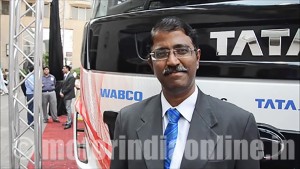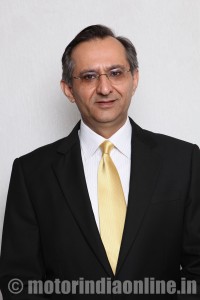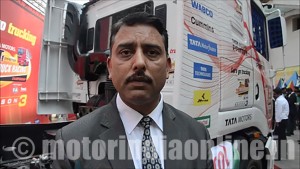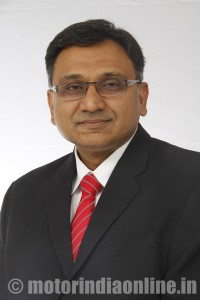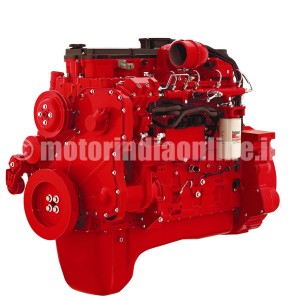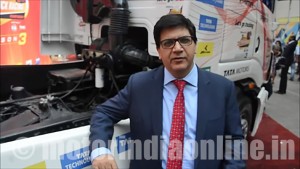Tata Motors, which conceptualized and introduced the T1 Prima Truck Racing Championship in 2014, revealed the names of 17 Indian truck drivers for the Season 3 of the much-awaited event. The selection of the ‘Indian Race Truck Drivers’, as Mr. R. Ramakrishnan, Senior Vice President, Product Strategy & Planning and Customer Value Creation, Commercial Vehicle Business Unit, Tata Motors, said, “was based on the company’s strategic objective of making the profession of truck driving aspirational and, at the same time, act as a catalyst to induct drivers into the future of T1.”
The inception of the ‘T1 Racer Program’, a driver development initiative, aimed at creating ‘PRIMA RACERS’ out of ordinary truck drivers is thus going to turn into reality for the first time on March 20 at the Buddh International Circuit.
The racing event hits two birds with a single stone. For starters, it brings respect to the truck driver’s fraternity. Driving a truck is not considered a good means of livelihood in India, given the harsh working conditions and constant pressures to deliver on time, along with a number of multiple employment options that have come up in the last couple of years. The race blows a new lease of life to the Indian commercial vehicle drivers. Second, it will prepare and encourage Indian drivers to look forward to, and participate in professional truck racing – a concept that has been so alien to the Indian trucking industry till 2014.
Commenting on the occasion, Mr. Ravi Pisharody, Executive Director, Commercial Vehicle Business Unit, Tata Motors, said: “Trucking is vitally important to the nation’s economy and the T1 Racer Program has been designed to help put a name and face to the men, who deliver essential commodities across the country every day. Since inception in 2014, with the T1 Prima Truck Racing Championship, we had made a conscious decision to give Indian drivers an opportunity to be part of this prestigious event, and today, are in the process of selecting the final 12. We are proud to have collaborated with our customers for a shared vision in promoting the profession of truck driving and are excited and honored to have these individuals, as the newest members of the T1 Prima Truck Racing Championship.”
In season 1, Tata Motors created history, by hosting the very first truck race in India. In season 2, the company showcased race trucks that were ‘Bigger, Better and Faster’. In season 3, Tata Motors is unfolding a new chapter in the history of Indian trucking, with the theme of ‘India to the World’ involving Indian talent, and is all set to create history yet again, in one of the world’s largest commercial vehicle markets.
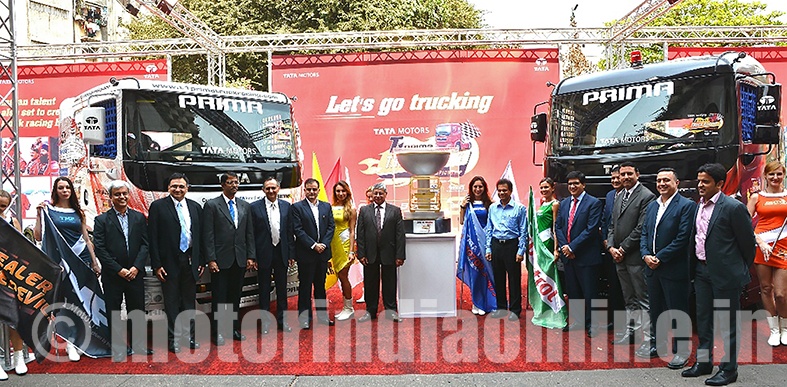
“With the T1 Racer Program having attracted over 550 nominations from our customers businesses, the ones shortlisted through the program today are based on driving experience, average kilometers driven in a year, along with the experience of negotiating different terrains. 17 have passed the Level 3 of the Indian Truck Racer program (TRP). The final 12 will be decided after Level 4 (Read Training Structure). We wish them the very best,” said Mr. Ramakrishnan.
Other highlights
Season 3 of the championship will continue to host experienced international drivers representing six teams, featuring 12 Tata PRIMA race trucks built for the purpose. On the race day, there will be two race categories, with four races – two ‘Super Class Race’ comprising Indian race truck drivers and two ‘Pro Class Race’ comprising internationally acclaimed drivers with proven experience in the field.
While Season 3 will witness Indian drivers competing in black Prima race trucks, which are identical to each other, in look and built, the six teams competing in the Pro Class of the T1 Prima Truck Racing Championship Season 3 will represent teams that participated in the previous two seasons of the championship, with one new team. These are Team Castrol Vecton (Champions of both the Seasons), Team Cummins, Team Tata Technologies Motorsports, Team Tata Motors Finance (the New Team), Team Dealer Warriors and Team Dealer Daredevils.
Tata Motors has also partnered with some of the country’s leading automotive brands for Season 3 of the T1 PRIMA Truck Racing Championship. They are WABCO – Official Braking Technology Partner, JK Tyre – Official Tyre Partner, Castrol – Official Lubricant Partner, Cummins – Official Engine Technology Partner, Tata Motors Finance – Official Commercial Vehicle Financing Partner, and Tata Technologies – Official Technology Partner.
The Prima Race Truck – 2016
Tata Motors also unveiled the new T1 2016 race truck, with a total 43 additional modifications, for a faster, more exciting Season 3. The Tata Prima 4038.S will compete in the T1 Prima Truck Racing Championship 2016, with the massive power of 370 BHP @ 2100 RPM and a top speed of just over 130 km/h. To make these Prima trucks fit for racing, key modifications were made to meet a mix of safety and performance needs as per the guidelines from the BTRA. These included significant changes in fuel tank, brake cooling system, propeller shaftguards, racing seats and safety belts, exhaust and steering wheel, among others. The trucks have gone through multiple quality checks and tested at Tata Motors Jamshedpur world-class testing facility, for high speed run and control, with many key modifications made to meet a mix of safety and performance needs.
The following are some of the changes to the T1 2016 race truck:
- Reduced centre of gravity by 100 mm, to improve dynamic stability at high speeds
- New lighter suspension system, to improve the ride and handling characteristics
- New improved shock absorbers, for stability during high-speed corner turns
- Improved brake cooling system with jet nozzles
- New lightweight aluminium fuel tank & water tanks
- New tyres of 315/70 R 22.5 introduced in place of 315/80 R 22.5, from last season
- Front flat wheel where mounting face offset is 127 in place of 175 from last season
Behind the scenes
The T1 Racer Program (TRP) aimed to provide a better life to the drivers, heighten their self-esteem, inculcate a sense of pride within their families and peers regarding trucking and give an opportunity to drive the ‘world truck Prima’ without any speed limits.
Tata Motors began the T1 Racer Program with the help of two key stakeholders – Accenture and MOMA (MOMA Motorsport Management). The team helped in addressing four key challenges:
- Driver sourcing – Who should be our target audience for the program?
- Racer shortlisting – How do we ensure selection of the best drivers from the entries received?
- Training Design – Designing an optimum training program for grooming talent in the limited time we have
- Program Management – Setting up of key processes to ensure a smooth functioning of such a mammoth event, high on manpower requirements
To further ensure Tata Motors received the best driver participation in a limited time frame, the company decided to source some of the most experienced Prima & tractor trailor drivers from customers. The plan was to reach a target of 500+ entries, after which the best 147 drivers where shortlisted. “Sourcing drivers from key accounts serves Tata Motors’ twin objectives, of meaningfully engaging with our customers while also getting a trustworthy source of experienced Prima/TT drivers,” revealed Mr. Ramakrishnan.
In order to secure the targeted number of nominations, Accenture and Tata Motors met the existing Tata Motors customers to explain to them the idea of T1 Racing and encouraged them to nominate their drivers.
These efforts culminated in the first milestone of 543 nominations from all over India, in a record time of two weeks. “We then applied the Racer shortlisting criteria, to select the top 147 racers for Level 1 of the training program,” averred Mr. Ramakrishnan.
Racer shortlisting criteria
Accenture designed comprehensive Racer shortlisting criteria in order to shortlist the drivers with maximum potential to be successful Prima Racers. This was first done through a simple nomination process, with some key parameters – Driver Experience and average km driven in a year. Age and Prima Driving Experience were given the highest weightages in the selection process, since they would have a strong influence on the track performance of a racer. These forms were then collated & digitized to create a central database of all participating drivers.
Training structure
Designing the training structure was unique, since race craft training was to be imparted to truck drivers who had no previous exposure to track driving. Many of them had never driven a Prima and had little or no formal education. The course material hence had to be made driver-friendly to ensure it could be grasped by this audience, and that too, in limited time.
MOMA designed a training program consisting of four Levels of training & elimination – Level 1 imparted elementary race theory & track driving lessons, Level 2 included a more intensive Prima-driving session, Level 3 involved rigorous physical and mental training sessions, and Level 4 enabled transition of a “road-driver” to a “Prima-Racer”.
Some of the best race instructors in India were roped in by MOMA, to be a part of this training program spread over a three-month window, from January 2016 to March 2016.
The short-listed drivers were grouped in batches of 8, 16 and 32 for Levels 1, 2 and 3 respectively. The training material was translated into Hindi, with pictorial depictions whereever possible, enabling better content interpretation by the drivers.
Programme management
The complexity of the programme demanded that several stakeholders work in tandem to ensure smooth functioning, for an event of this scale. Complex webs of stakeholders’, their roles were etched out for this purpose. Teams from Tata Motors Legal, Insurance and Regional Key Accounts were identified as important internal stakeholders.
While the Legal and Insurance teams at Tata Motors provided valuable inputs on vehicle and driver safety, Key Account teams from regions were instrumental in confirming driver participation and co-ordination for driver travel & stay.
The next step in the journey was to ensure that all the 147 selected racers were able to make it to Level 1 of the training program and given a truly “WOW” experience for them to cherish for the rest of their lives, with best travel & stay facilities being made available for the drivers. Most drivers were first-time airline flyers.
Starting January 8, 2016, 132 drivers from all over India underwent the Level 1 training program, with 64 drivers making it to Level 2. Post this, Tata Motors selected 26 of semi-finalists for the intensive Level 3 training program, during February 8-11.
Most drivers showcased keen interest to learn concepts being taught to them and were truly overwhelmed by the overall experience. “For several, this was the first time they had formal training, growing extremely close to their mentors, during the course of the program. Feedback sessions served as a window into their thoughts, aspirations and expectations of the truck driver community and greatly enriched our understanding of their key motivations & beliefs. It was terrific to see how eager and excited they were to transform themselves from highway drivers to race drivers,” explained Prabha Shankar, MOMA, Motorsport Management.
Final frontier
The journey from Road to Race-Track is nothing short of a fairy tale for many of the Indian drivers. The series of many firsts for these drivers made it an extremely emotional experience for most of them. Once the finalists are chosen post Level 3, they will be engaged in several activities over the next one and a half month like:
- Training from Global experts at BIC – There will be a training schedule for more than a week at BIC by Global truck racing experts for all finalists
- Month-long phase of engagements and trainings, finally culminating into the T1 Season 3 Finale at BIC, Noida, on March 20, with Indian drivers participating for the first-ever “Indian Truck Racer” trophy.
Tata Motors and T1 Prima Truck Racing, a recap
Tata Motors, the largest manufacturer of commercial vehicles in India, has brought this very popular sport to India as ‘T1 Truck Racing Championship’, under the aegis of FIA and FMSCI, marking yet another pioneering effort by the company in the Indian commercial vehicle industry. It proved to be an exciting and exhilarating event, drawing huge crowds to the Buddh International Circuit. Stuart Oliver from Team Castrol Vecton won both the previous championship.
The success of the race backed the rationale behind introduction of this unique motor sport by Tata Motors that the 2nd generation of the existing fleet owners are better travelled and educated, on the look-out for other business options, and this can eventually increase Tata Motor’s business. It also emerges as a platform where Tata Motors can showcase new generation technologies and make driving an attractive employment option in the country.
About the Tata PRIMA range
Being developed with its subsidiary, Tata Daewoo Commercial Vehicles (TDCV), Tata Motors conceived the award winning Tata PRIMA range, setting new benchmarks in the performance and design of a next-generation commercial vehicle, based on superior technology, optimum power, fuel efficiency and safety.
Built with technical inputs from across the world, the Tata PRIMA range is based on an Italian cab design, engine technology from the US and Europe, gearbox expertise from Germany, chassis frame know-how from Mexico, and sheet metal dies from Japan and Korea. Combining Swedish precision on a robotic weld line, it is also referred to as the ‘World truck’ by Tata Motors.
Equipped with strong aggregates and a robust chassis frame and suspension, the Tata PRIMA range meets the highest operating standards under extreme conditions, thanks to outstanding material and build quality, comfort and driving dynamics, offering the lowest cost of operation.
A multiple award-winning range of trucks from Tata Motors, the Tata PRIMA is today available in different trims, including multi-axle trucks, tractor-trailers and tippers, apt for several applications, thus meeting varied end-user requirements. With its power, sustainable speed, safety and reliability, best-in-class aggregates, cabin features and comfort, it was uncompromisingly designed for long-distance/ hours of transportation.
Truck racing-a motor sport
Truck racing is a form of motor racing that involves modified versions of heavy tractor units on racing circuits. The sport began in the US at the Atlanta Motor Speedway, on June 17, 1979.
In the last few years the profile of truck racing has grown, with over 30 teams regularly competing in various championships. Races start from a rolling start, and commonly last from 8 to 12 laps. It is a non-contact sport.
All drivers must hold a race licence issued by Motor Sports Associations, or the national motorsport body from the driver’s country. The major truck racing championships are:
- FIA European Truck Racing Championship (gathering 80 million TV viewers in 209 countries)
- British Truck Racing Championship
- NASCAR Camping World Truck Series (US), rapidly gaining foothold as a highly watched motorsport event in the US
- Fórmula Truck (Brazil)
- French Cup Trucks (France)
WABCO reaffirms commitment
Right from the inception of T1 Tata Prima Truck Racing Championship, WABCO has been associated with Tata Motors as its sole braking partner. The association between the two goes back to five decades where the former provides the CV maker with leading braking safety and efficiency technologies. Last year WABCO was honoured with the Supplier of the Year Award by Tata Motors. “For the T1 Prima Truck racing Season 3 we continue to provide anti-lock braking systems, modular compressor, high processing air performers and air actuation systems. We are also working on many future safety technologies like Electronic Braking System, Autonomous Emergency Braking System and Lane Departure Warning Systems with Tata Motors,” revealed V. Ramanathan, V.P. – OE Sales and Marketing, WABCO India Ltd.
JK Tyre grooves in with heat reduction tyres
JK Tyre has played a pivotal role in making India a motorsport hub. The company has promoted motorsports in India for over three decades and has strived to bring it at par with the global landscape. “T1 is a great platform for us to showcase our product efficiency. We have developed highly advanced truck racing tyres, especially for this initiative. It helps us showcase our products in terms of technology orientation, quality, reliability and safety. Association with truck racing will help us to develop world-class tyre designs and develop an understanding of advanced technologies, performance engineering solutions,” said Mr. Vikram Malhotra, Marketing Director, JK Tyre and Industries Ltd.
For T1 race trucks, JK Tyre’s core focus was to meet the gruelling condition of the race circuit, especially keeping in mind that the race was going to happen at the close of March when temperature would shoot. “We took initial trials simulating the race condition and analysed the increase in temperature at different locations using infrared thermography. We later fine-tuned our grooves in order to reduce heat generation. Matching it with the requirements of braking was a challenge which we could meet,” explained Mr. Malhotra.
The requirements, as it appears, are different from a standard radial tyre. “We have used a shallow groove pattern with an asymmetric profile and asymmetric shoulder drop to meet the racing requirement of the peak spead of 160 km/hr. Tata Motors is an admirable brand and we are happy to be partnering with them again for the third season. We are optimistic that our synergies will translate into this championship becoming a much-revered sport in India, similar to what it is globally,” concluded Mr. Malhotra.
Castrol packs punch with add-ons
Castrol has been proudly associated with T1 Prima Truck Racing as an exclusive lubricant partner for last three years. “In 2015 we launched the Castrol Vecton Fuel Saver, the first co-engineered product for Tata Motors Commercial Vehicles. The product delivers 3 per cent better fuel efficiency in rough terrain of Indian driving condition. We are working closely with Tata Motors for products that can go into BS-VI engines by 2020. Apart from the Vecton Fuel Saver product we are also partnering with T1 Prima Racing and Tata Motors, particularly for skill development, safety across their dealership, and have launched a manual for training people in their workshops. This year we are coming up with a CSR activity called Castrol Jagruti to develop a safety culture in their workshops,” beamed Rajeev Govil, V.P. – OEM and Workshops, Castrol India.
Castrol is thus going beyond developing products by adding services that can evolve the entire value chain.
Cummins honours T1 Prima Racing with powerful engine
The T1 PRIMA Truck Racing Championship offers Cummins an ideal platform to showcase the endurance and reliability of its engines, which are built to deliver best performance in the toughest of conditions. Cummins has been a global technology leader, exceeding customer expectations by always being the first to market with the best products. “We have been doing this consistently for 97 years now globally and in India for 54 years. Behind such legendary events are instances of great innovation and inspiration that Cummins honours. The same passion for engines and technology that inspires owners and drivers, also inspires our engineers, researchers, and service professionals here at Cummins,” beamed Ashwath Ram, Vice President, Engine Business, Cummins India Ltd.
Asked about the specification of the engine used for Season 3 of T1 Prima Racing, he was quick to add: “The high performance 380 BHP @ 2100 RPM Cummins ISLe 8.9 engines offer drivers an advantage of high acceleration, with reliability and durability. To make the race exciting and thrilling, based on the feedback from the previous season, the engine calibration has been tuned to offer better transient response and its performance has been amplified to achieve top speed of 130 km/h, as compared to the 110 km/h speed limit in the first season.”
Engine specs:
* Engine model: ISLe 8.9L 380 hp BS3 l Engine power: 380 hp @ 2100 rpm
* Engine torque: 1550 Nm @ 1200 rpm l Engine type: 6 cylinder
* Vehicle model: Prima 4038.S l Dry weight: 706 kg
Tata Technologies focuses on light weighting
Tata Technologies has been part of the event since inception in 2014. The company has been a strategic partner to Tata Motors and has evolved the relationship from day one. “Our engineers have been part of the initial World Truck Design, the modification in Season 2 and a little bit of tweaking in Season 3. They have not only given a lot of time in engineering these trucks but have also been involved in worldwide engineering programmes, especially in light weighting,” explains Samir Yajnik, President, Global Delivery, and COO Asia Pacific, Tata Technologies Ltd.
“We conceptualized our own Electro mobility vehicle – an EV vehicle – and the lesson from there are to use mixed material or light weighting materials. That is how we apply the learning here in this season, and thus light weighting has been the main theme, this Season for us,” Yajnik revealed.
Truck racing will spread a lot of optimism for commercial vehicle driving in India, Mr. R. Ramakrishnan, Senior Vice President, Product Strategy & Planning and Customer Value Creation, Commercial Vehicle Business Unit, Tata Motors, answers a number of questions related to truck racing, in an exclusive interaction with MOTORINDIA.
Excerpts:
How much has the tuck racing helped Tata Motors achieve its purpose of bringing dignity to truck drivers? What does it means to the entire trucking fraternity?
RR: The race has become a huge hit with not only the spectators, (25,000 in the first season and almost 50,000 in the second season), but it is a huge hit with the drivers and their families. Seeing the entries that we got for this year’s Indian truck drivers and the excitement shown by the fleet operators who nominated their drivers, Tata Motors has so far achieved what it aspired for and that brings some value and dignity to the life of these Indian truck drivers. By creating a pool of Indian truck drivers who can become race drivers, we only want to take the profession of driving a truck a notch higher. This will mean a lot for the entire trucking fraternity that faces severe driver shortage.
Are the Indian drivers going to drive the same truck as the British drivers or are there an easier truck configured for them?
RR: Both Indian and the British Truck drivers will have the same trucks with exactly the same specification. The only difference is that the races are different, and not in the same one open race. There will be two races for the Indian truck drivers, six trucks each known as Super Class. Each race will give us two Indian truck drivers as winners. There will be two races for the international drivers. The trucks with the Indian drivers will have a black colour with a tinge of red in it, whereas for the international racers will be similar to last two seasons, representing sponsors. Both the Indian and international drivers will be driving the latest specification vehicles. For international drivers, one will be a qualifying race and the other a final.
What happens to the Indian truck drivers after the truck racing? Do you have any plan or programme to take them to the international level or any other recognition?
RR: These are Indian truck drivers and driving is their livelihood, so they will go back to their profession. But there will be fundamental changes that will happen to them after the race. They will go with a lot of pride and encourage others to take up the profession and participate in the future races. When they go back to their homes, between their families they will definitely speak about the treatment they received, the little brush with glory and how someone is trying to uplift their entire profession. The truck racing will spread a lot of optimism for driving in their villages, within the company that they are working. They will be regarded as heroes, and then there will be more of our customers who will nominate their drivers to participate in the race. The ripple effect will see a lot of respect for drivers and trucking as a profession. As of now, we have drivers that are with par with the international drivers that can compete in international races abroad, but when will this happen, what will be the time phrame for that, we haven’t thought of it. But definitely it is something that, we would want to do in the future to give further prominence to the Indian truck drivers. In the next 2-3 years we may ourselves host an open race between the Indian and the international drivers.
Truck racing is all about speed, whereas on road it is more about power and mileage. Is there a particular technology for the race truck that Tata Motors wants to bring on the roads?
RR: Our objective was definitely to showcase the technology and the prowess of the Prima Truck. Prima itself is a technological innovation which stands for contemporary trucking rather than the conventional one. Both in terms of brand visibility and business, we have got business from Prima. There are many distributors/dealers who after seeing the racing have ordered the Prima. There are still a number of things that can be done in terms of ride and handling, light-weighting, use of aluminum tanks for diesel, air tanks water tanks, etc., depending on the roads. We also experiment with suspensions and ride and handling since the infrastructure and speed limit of different country may vary. The vehicle performs differently in a country like ours with, say, a speed of 80 kmph versus 110/120 kmph in some other countries. So, some of the techniques that we have used to improve the ride and handling of these race trucks will come in handy when we make vehicles which need those speed limits.



